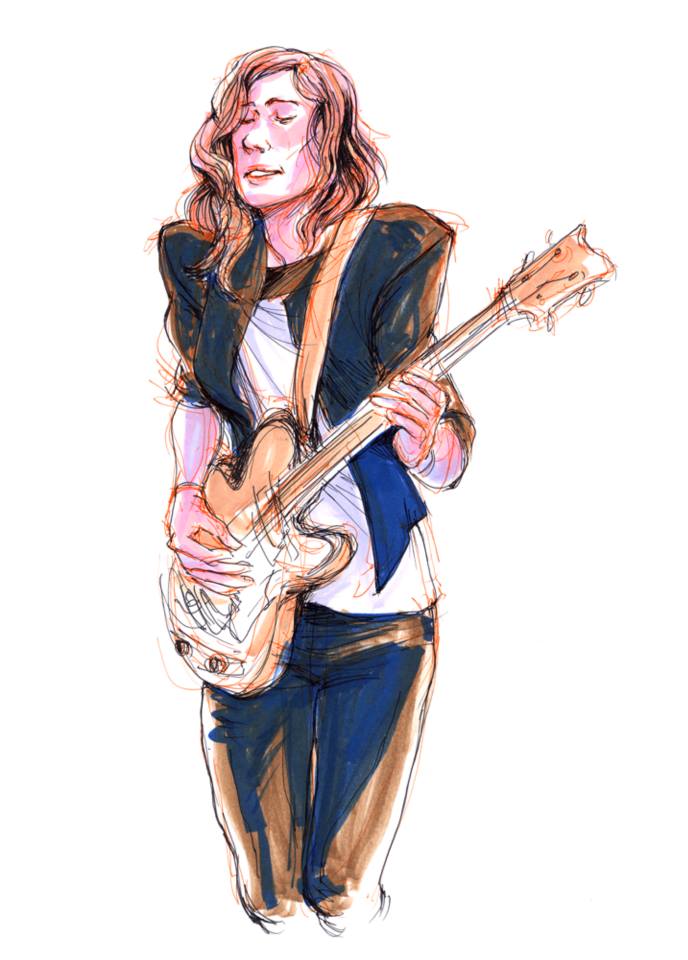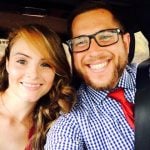Jennifer Kennedy wants to be bored.
Jennifer Kennedy wants to be bored.
The 28-year-old artist, now a near constant presence at local shows in Richmond, admits that she finds her most creative moments when her drawings begin to feel just a little stale.
As Kennedy sees it, drawing the same band or person over and over encourages new creative possibilities.
“It’s really fun when you decide you’re bored with the way the drawing starts looking, because then you don’t have to care about making drawings like that anymore,” she explained. “It frees you in a way. Like, ‘Oh, I’m bored? Oh, no, I’m free!’”

It’s difficult to imagine her work as boring. Kennedy rose to prominence locally due to her extensive and somewhat unusual documentation of bands in Richmond. Instead of photos, she opts for pencil and paper, sketching bands in as much motion as can be put on a page in high contrast color, often mimicking the stage lights on her subjects.
Kennedy is a fixture in the front row at shows several nights a week, sometimes opting for an altered sleep schedule to maintain her 9-to-5 as a Geographic Information Systems Analyst at Timmons Group. Sometimes she will come home from work, sleep for a few hours, then wake up to sketch a house show later in the evening.
I asked her if it felt like she was living 14 days instead of 7 as a result. She somewhat resignedly, but good-naturedly, shrugged it off.

Flipping through old sketchbooks, recent drawings, and her senior art project in her cozy Fan apartment, she expanded on her process and its development over the six years she has been in Richmond and beyond. A black cat, Jiji, named for the cat in Kiki’s Delivery Service, darted back and forth across the living room stuffed with bookshelves and small, comfy chairs.
After college, Kennedy worked on a sheep farm. After that job ended, she decided to move to Richmond, where her younger brother Mike was attending Virginia Commonwealth University. Kennedy has used art as a way to support her favorite bands since she moved to Richmond, but the act of documentation itself began beforehand.
Appropriately, it began at a show played by her younger brother in a now-defunct space in Vienna, Virginia called the Soundry, a coffee shop, for-rent studio space, and music venue.
Kennedy landed on her particular art form through a need to have something to do while she watched her brother perform. As it was an unfamiliar venue in an unfamiliar place, Kennedy decided to bring along her sketchbook.

“As an anxious person, I want to feel like I’m there for a reason,” she said. So she created a reason—drawing and documentation. Better yet was the discovery that she liked drawing bands. An artist initially interested in portraiture, Kennedy connected with the atmosphere and emotional resonance of live performance.
It helped, too, that sketching provided a reason for her to be close to the stage.
Kennedy’s brother, Mike, a graphic designer and musician living in Chicago, couldn’t remember the first time his sister drew his band, but he could immediately see the appeal in it.
“I think one of those first sketches was my profile picture for months,” he said.
According to her brother, Kennedy always kept a sketchbook nearby, even documenting her dreams into sketches in high school.
Dreams often have high emotional resonance with the dreamer, and Kennedy seems to prize emotion in her work. In particular, she is interested in portraiture with emotion.
In college at Carnegie Mellon, she disliked the fine arts conception of figure drawing, which bases itself mainly in the mechanical aspects of drawing people.

“I wanted to do portraiture. I’ve always really wanted to do that,” she said. “Which is actually really funny with figure drawing, because I end up creating drawings of really bored or sleepy looking people.” She paused slightly. “Who are also naked.”
That she is interested in catching a likeness, however fleeting, is obvious in her current work. Back in her apartment, she flipped through her sketchbooks, her early drawings precisely penned on the pages of long landscape sketchbooks.
She was interested in precision then, in the literal figuration of the artist in one color. Now, she prefers large books—perhaps for the increased room to sketch an artist’s movement with multiple colors and pencils.
Drawing live performances forced Kennedy to abandon her more perfectionist tendencies and adopt a more free-form style, starting with sketchy, colorful “underdrawings” of the musician’s shifting positions before silhouetting the artist in black and colored marker.
She has certain rules to her sketches—a sketch of one band (or band member, as is usually the case) must be finished once the set is over. There’s no going back to it after the set has finished and the band has left the stage.
This method starves out any compulsion she might have to return to the work after it is “finished.” As it is a documentation of a live event, in Kennedy’s opinion, it doesn’t necessarily need to be polished.

Nor does it need to be reprinted—what she does, as she sees it, is pure documentation of a live event, and its intended purpose is to convey only that event. Which is why Kennedy shies away from the idea of potentially using her work to create album art.
“I want the album art to be more of a conversation with the music rather than, maybe, just the façade or image of the people playing the music. It feels too literal in a way.”
Musicians documented by Kennedy, such as Lucy Dacus and Sera Stavroula of Toxie Moxie, see the opportunity to be drawn by her as both a uniquely RVA honor and, in some ways, a more emotionally resonant memento than a written review or photograph.
“I think her style of documenting Richmond music occupies its own place in the scene,” said Dacus. “It’s capturing the live performance, not in the way that a camera or an article would. It’s creativity that relies on creativity, which is a great way to mutually encourage each other’s art.”

Being drawn by Kennedy is a badge of honor among musicians, according to both Stavroula and Dacus.
“Her choice of subject has an unspoken message of ‘you are special,’ and that… can carry a new artist to next a level of confidence.” Dacus explained. “It’s refreshing to see such a commitment to highlighting lady acts, because it will only inspire more to exist.”

Overall, in Dacus and others’ view, the average photo encapsulates a moment, but Kennedy’s drawings capture far more.
What is left unsaid in communication is yet another one of Kennedy’s interests as an artist. Though her drawings seem to make the implicit—that there was a show, that there was motion, that there was music to move to—explicit, the negative space of her drawings is the actual atmosphere of the show.
Her figures are larger-than-life, one striking silhouette against layered, sketchy under-drawings. The layers of sketch convey full motion. The fully-inked figures stand against empty backgrounds, letting the viewer imagine the scene around them. Such empty space communicates in its emptiness, the emotions and figuration of the subject taking precedence over their context.
The focus then becomes the musicians, and the musicians only, perhaps allowing a viewer to relive the moment of the drawing’s conception through the figure’s sheer passion.

“[Kennedy is] able to capture movement and passion in a way that I think helps us take joy in the memories we have of those shows, of those artists, and perhaps in our own development as people and musicians,” Stavroula said.
If anything, a viewer can certainly see Kennedy’s own energy shine through her portraits. Her movement of pencil to page is certainly important, but to achieve the gestural sketches that convey the motion and energy of the show, her whole body moves to create the image.
“I kind of have to dance it out onto the page—I’m dancing it into existence, onto the sketchbook. The more energy they put out, the more energy I put into it.”
This isn’t an exaggeration on her part, either—having watched her at shows, I have seen her dance a drawing onto her sketchbook into the world, her movement a call-and-response between artists.
As the band begins to settle into their set, Kennedy almost mimics her subject’s movements. She fades into the background even as she increasingly stands out as a staple of the RVA music scene.

Continuing to expand her horizons, Kennedy looks forward to a number of new projects in 2016. She has spoken in the past about documenting bands on tour (most particularly Avers) and hosting an exhibit in a local gallery, but in the coming weeks she has set her sights on uplifting marginalized members of the local music scene.
A recent project with Girls Rock! RVA will have her line drawings published into a coloring book with proceeds going to benefit the organization, an idea that came from Kennedy’s frustration with the uncolored preliminary sketches she would draw during short-lived sets.
“If they had just played for 10 more minutes, I would have had so much color on this drawing,” she said, expressing her frustration with the unfinished products of short sets. “I should just make a coloring book and have other people color it in.”
Three months later, Kennedy had the thought: what if she actually did just that?
Frustration developed into inspiration, leading Kennedy to friend and organizer Lindsey Spurrier, who in turn set the project in motion with musician Patty Conway, Girls Rock! RVA’s lead organizer.
The project coincides neatly with Girls Rock’s own goals in empowering young LGBTQ and gender non-conforming musicians in the Richmond area.
“All of the organizers at Girls Rock are thrilled [by the collaboration],” Conway says. “We are all such huge fans of Jennifer’s work.”
For now, though, she is content to dance her drawings out into the world, waiting for the next time that she becomes just a little bored with the way she’s been doing things. Here’s hoping she stays free.



